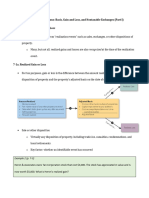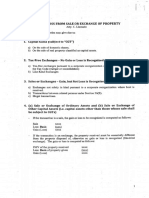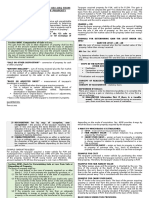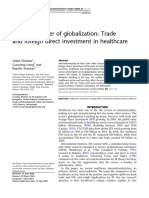TA Xes: Transactions in Property: (5) The Basis of Like-Kind Property Received Is The Basis of Like-Kind Property Given
Uploaded by
El Sayed AbdelgawwadTA Xes: Transactions in Property: (5) The Basis of Like-Kind Property Received Is The Basis of Like-Kind Property Given
Uploaded by
El Sayed AbdelgawwadMODULE 34 TA.
XES: TRANSACTIONS IN PROPERTY 493
(a) Real property must be exchanged for real property; personal property must be exchanged
for personal property within the same General Asset Class or within the same Product
Class. For example
1] Land held for investment exchanged for apartment building
2] Real estate exchanged for a lease on real estate to run thirty years or more
3] Truck exchanged for a truck
(b) Exchange of personal property for real property does not qualify.
(c) Exchange of US real property for foreign real property does not qualify.
(4) To qualify as a like-kind exchange (1) the property to be received must be identified within
forty-five days after the date on which the old property is relinquished, and (2) the exchange
must be completed within 180 days after the date on which the old property is relinquished,
but not later than the due date of the tax return (including extensions) for the year that the old
property is relinquished. '
(5) The basis of like-kind property received is the basis of like-kind property given.
(a) + Gain recognized
(b) + Basis of boot given (money or property not of a like-kind)
(c) - Loss recognized
(d) - FMVofbootreceived
(6) If unlike property (i.e., boot) is received, its basis will be its FMV on the date of the exchange.
(7) If property is exchanged solely for other like-kind property, no gain or loss is recognized. The
basis of the property received is the same as the basis of the property transferred.
(8) If poot (money or property not of a like-kind) is given, no gain or loss is generally recognized.
However, gain or loss is recognized if the boot given consists of property with a FMV differ-
ent from its basis. .
EXAMPLE: Land heldfor investment plus shares of stock are exchanged for investment real estate with a
FMV of $13,000. The land transferred had an adjusted basis of $10,000 and FMV of $11,000; the stock had
an adjusted basis of $5,000 and FMV of $2,000. A $3,000 loss is recognized on the transfer of stock. The
basis of the acquired real estate is $12,000 ($10,000 + $5,000 basis a/boot given - $3,000 loss recognized).
(9) If boot is received
(a) Any realized gain is recognized to the extent of the lesser of (1) the realized gain, or (2)
the FMV of the boot received
(b) No loss is recognized due to the receipt of boot
EXAMPLE:' Land held for investment with a basis of $10,000 was exchanged for other investment real
estate with a FMV of $9,000, an automobile with a FMVof $2,000, and $1,500 in cash. The realized
gain is $2,500. Even though $3,500 of "boot" was received, the recognized gain is only $2,500 (limited
to the realized gain). The basis of the automobile (unlike property) is its FMV $2,000; while the basis of
the real estate acquired is $9,000 ($10,000 + $2,500 gain recognized - $3,500 boot received).
(10) Liabilities assumed (or liabilities to which property exchanged is subject) on either or both
sides of the exchange are treated as boot.
(a) Boot received-if the liability was assumed by the other party
(b) Boot given-if the taxpayer .assumed a liability on the property acquired
(c) If liabilities are assumed on both sides of the exchange, they are offset to determine the
net amount of boot given or received.
EXAMPLE: A owns investment land with an adjusted basis of $50,000, FMV of $70,000, but which is
subject to a mortgage of $15,000. B owns investment land with an adjusted basis of $60,000, FMVof
$65,000, but which is subject to a mortgage of$10,000. A and B exchange real estate investments with A
assuming B's $10,000 mortgage, and B assuming A 's $15,000 mortgage. The computation of realized
gain, recognized gain, and basis for the acquired real estate for both A and B is as follows:
You might also like
- Nontaxable Exchanges Like-Kind Exchanges - 1031No ratings yetNontaxable Exchanges Like-Kind Exchanges - 10316 pages
- Property Transactions: Gain or Loss and BasisNo ratings yetProperty Transactions: Gain or Loss and Basis37 pages
- Taxes: Transactions in Property: Involuntary ConversionsNo ratings yetTaxes: Transactions in Property: Involuntary Conversions1 page
- M AX N N: Odule T Es: Transactio SI PropertyNo ratings yetM AX N N: Odule T Es: Transactio SI Property2 pages
- Taxes: Transactions in Property:) S - C S - S S o y S y S - S" e S A A A S G S. X S, ANo ratings yetTaxes: Transactions in Property:) S - C S - S S o y S y S - S" e S A A A S G S. X S, A3 pages
- Property Transactions: Determination of Gain or Loss, Basis Considerations, and Nontaxable ExchangesNo ratings yetProperty Transactions: Determination of Gain or Loss, Basis Considerations, and Nontaxable Exchanges97 pages
- CPAR Sale or Exchange of Property (Batch 89) HandoutNo ratings yetCPAR Sale or Exchange of Property (Batch 89) Handout7 pages
- Gain or Loss From Sale or Exchange of PropertyNo ratings yetGain or Loss From Sale or Exchange of Property37 pages
- Chapter+7 Part+I Before+class+notes+ PDFNo ratings yetChapter+7 Part+I Before+class+notes+ PDF10 pages
- Definitions - No Definition in The Code For: G. Capital Gains & LossesNo ratings yetDefinitions - No Definition in The Code For: G. Capital Gains & Losses5 pages
- 007 Gain or Loss From Sale or Exchange of PropertyNo ratings yet007 Gain or Loss From Sale or Exchange of Property12 pages
- CPAR Sale or Exchange of Property (Batch 93) HandoutNo ratings yetCPAR Sale or Exchange of Property (Batch 93) Handout7 pages
- CPAR Sale or Exchange of Property (Batch 96) HandoutNo ratings yetCPAR Sale or Exchange of Property (Batch 96) Handout7 pages
- Chapter 8 (Pages 272-Top of 288) Tax-Deferred ExchangesNo ratings yetChapter 8 (Pages 272-Top of 288) Tax-Deferred Exchanges2 pages
- Acquisition Costs Include The Purchase Price, Tax Assumed, and Acquisition-Related CostsNo ratings yetAcquisition Costs Include The Purchase Price, Tax Assumed, and Acquisition-Related Costs6 pages
- Principles of Taxation for Business and Investment Planning 2019 22nd Edition Jones Solutions Manual download100% (2)Principles of Taxation for Business and Investment Planning 2019 22nd Edition Jones Solutions Manual download47 pages
- Principles of Taxation for Business and Investment Planning 2019 22nd Edition Jones Solutions Manual - 2025 Version Is Available With All Chapters100% (3)Principles of Taxation for Business and Investment Planning 2019 22nd Edition Jones Solutions Manual - 2025 Version Is Available With All Chapters49 pages
- CCH Federal Taxation Comprehensive Topics 2013 1st Edition Harmelink Test Bank100% (34)CCH Federal Taxation Comprehensive Topics 2013 1st Edition Harmelink Test Bank20 pages
- 2022 Providing Clarification and Guidance On20220425 12 17f0pjiNo ratings yet2022 Providing Clarification and Guidance On20220425 12 17f0pji8 pages
- Principles of Taxation for Business and Investment Planning 2018 21st Edition Jones Solutions Manual download100% (2)Principles of Taxation for Business and Investment Planning 2018 21st Edition Jones Solutions Manual download48 pages
- RR 18-01 Basis of Property Transferred and Shares Received - 11.13.01No ratings yetRR 18-01 Basis of Property Transferred and Shares Received - 11.13.0111 pages
- Tax Treatment of Forex Gains or Losses For BusinessesNo ratings yetTax Treatment of Forex Gains or Losses For Businesses23 pages
- TAX Determination of Gain or Loss From Sale or ExchangeNo ratings yetTAX Determination of Gain or Loss From Sale or Exchange14 pages
- US Internal Revenue Service: p551 - 1994No ratings yetUS Internal Revenue Service: p551 - 199412 pages
- Solved Carol Owns Land Used in Her Business With A Basis PDFNo ratings yetSolved Carol Owns Land Used in Her Business With A Basis PDF1 page
- Module 22 Federal Securities Acts and Antitrust LawNo ratings yetModule 22 Federal Securities Acts and Antitrust Law2 pages
- C Ayton Act of 1914: Module 22 Fe E A SE UNo ratings yetC Ayton Act of 1914: Module 22 Fe E A SE U2 pages
- M Dule 22 Federal Securities Acts and Antitrust LawNo ratings yetM Dule 22 Federal Securities Acts and Antitrust Law2 pages
- Agency: I. Formation of The Agency RelationshipNo ratings yetAgency: I. Formation of The Agency Relationship7 pages
- Module 22 Federal Securities Acts and Antitrust LawNo ratings yetModule 22 Federal Securities Acts and Antitrust Law2 pages
- Federal Securities Acts and Antitrust LawNo ratings yetFederal Securities Acts and Antitrust Law3 pages
- P L N L U N N T MP: Sarbanes-Ox Eyactof2 2No ratings yetP L N L U N N T MP: Sarbanes-Ox Eyactof2 22 pages
- Federal Securities Acts and Antitrust Law: C o C eNo ratings yetFederal Securities Acts and Antitrust Law: C o C e2 pages
- Module 26 Secured Transactions:: o C, G eNo ratings yetModule 26 Secured Transactions:: o C, G e2 pages
- Module 26 Secured Transactions:: S G S C R eNo ratings yetModule 26 Secured Transactions:: S G S C R e2 pages
- Fi V Y, A (A A y I R S (B) A R S Si: Secured TransactionsNo ratings yetFi V Y, A (A A y I R S (B) A R S Si: Secured Transactions2 pages
- Toxic Masculinity and Gender Equity in The Australian Defence ForceNo ratings yetToxic Masculinity and Gender Equity in The Australian Defence Force3 pages
- HUDCC Guidelines For Identification of Lots and Sites For Socialized HousingNo ratings yetHUDCC Guidelines For Identification of Lots and Sites For Socialized Housing6 pages
- China's Governance Model - Flexibility and Durability of Pragmatic Authoritarianism (کتاب دوست)100% (1)China's Governance Model - Flexibility and Durability of Pragmatic Authoritarianism (کتاب دوست)369 pages
- Z@@Shenkar2022 Article TheLastFrontierOfGlobalizationNo ratings yetZ@@Shenkar2022 Article TheLastFrontierOfGlobalization13 pages
- (Ebook) Dark Goddess Craft: A Journey Through the Heart of Transformation by Woodfield, Stephanie ISBN 9780738752563, 9780738754079, 0738752568, 0738754072 all chapter instant downloadNo ratings yet(Ebook) Dark Goddess Craft: A Journey Through the Heart of Transformation by Woodfield, Stephanie ISBN 9780738752563, 9780738754079, 0738752568, 0738754072 all chapter instant download65 pages
- Answer:: What Is "Pu" in Electrical Engineering?No ratings yetAnswer:: What Is "Pu" in Electrical Engineering?4 pages
- Lecture On Database by Miss Aysha (GCUF)No ratings yetLecture On Database by Miss Aysha (GCUF)6 pages
- Communicative Activities For Middle School Classroom PDFNo ratings yetCommunicative Activities For Middle School Classroom PDF3 pages
- Umali V JBC July 25, 2017 G.R. No. 228628 Velasco, JR., J. FactsNo ratings yetUmali V JBC July 25, 2017 G.R. No. 228628 Velasco, JR., J. Facts1 page























































































































